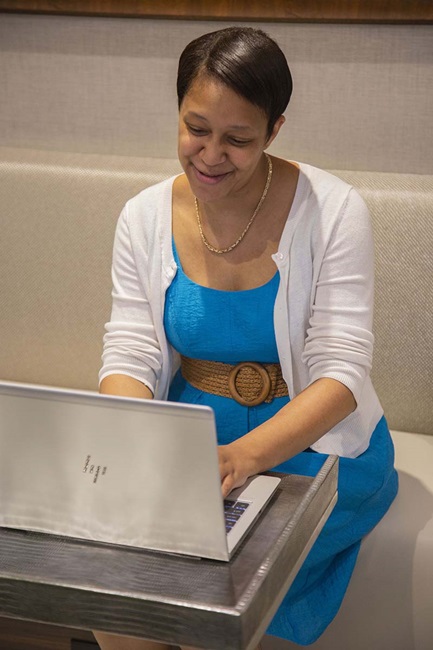
GIVING A SCIENCE PRESENTATION TO NON-SCIENCE AUDIENCES
What goes into a presentation?
Giving a presentation is a staple of the scientific experience. Whether it’s in front of a classroom, at a scientific conference, or at an outreach event to a non-science audience, being prepared for a presentation is key to effectively communicate your science message. Below we’ll provide details on how to give a presentation to non-science audiences.

Helpful hints
- This is not your usual conference talk or audience. Your group is interested in hearing about your work but not in the same way as your peers. Make your science accessible.
- Avoid jargon and define acronyms. Eliminate the perception that science is inaccessible by avoiding language and terms that are specific to your field. Check out the Upgoer 5 activity as an exaggerated example of a way to simplify your message.
- Speaking is different from writing. Think about your audience. Factors such as voice inflection, shorter and simpler sentence structure, and real-time audience reactions are important to keep in mind while giving your talk.
- Don’t read from your slides. Provide just enough content on your slides as cues; write down reminders and numbers that prompt you. If you’re using separate notes, use a large font that you can read easily.
- Avoid slides with excessive text. Too much text will distract both you and your audience from your talk. However, interesting photos and clear diagrams that explain processes (e.g. the carbon cycle) can be engaging.

Presentation best practices
Find a venue.
Spread the word.
Prepare your materials.
You may want to provide fact sheets, brochures, or other handouts or information on how audience members can learn or do more.
Plan your agenda.
Are you just giving a talk with Q&A to follow? Do you have props/exhibits? Is the event more discussion based?
Tailor your design.
Be sure to tailor your presentation to your audience and your venue. Are you using PowerPoint or visual props? Make sure the location supports your desired needs (e.g. AV equipment) and know your audience (e.g. their backgrounds, demographics, goals).
Test everything.
Don’t just practice your speech at home – make sure you have enough time to test out all AV equipment before your talk. If your presentation requires sound, confirm whether there are speakers and test them onsite. If you need a clicker, be prepared to set it up. If you are taking your own computer, be sure to have all the necessary adapters and equipment for the venue. If you use a Mac but the venue has a PC, be sure that all documents and media are compatible (saving your presentation as a PDF will ensure the correct fonts display). Sometimes the formatting of presentations change if you switch between PC and Mac.
Keep slides brief.
Use one image, idea, or a clear figure, to illustrate, rather than reiterate, your points. You don’t want your audience to have to sift through too much information on your slides.
Practice your talk.
Practice your presentation out loud and ideally to a non-science audience like family or friends. If an audience is unavailable, video yourself to see where you can improve. Tip: If you have a smartphone, you have a video camera. How do you sound? We’re not talking about whether you’re in tune, but rather, how well are you delivering your message? Practice your enunciation, voice projection, breathing, and pace, and remember to speak at an appropriate volume. You want to sound natural and comfortable throughout your presentation. How do you look? We’re not talking about your phenotype, but rather, how do you present yourself? Is your posture too stiff or too slouchy? Your body language
will help engage your audience, so you want to appear confident and approachable. Be deliberate in your actions. Regardless of whether you are animated or more reserved in your actions when communicating, be sure that gestures are deliberate rather than coming across as fidgety and uncertain.
How do you look?
We’re not talking about your phenotype, but rather, how do you present yourself? Is your posture too stiff or too slouchy? Your body language will help engage your audience, so you want to appear confident and approachable.
Be deliberate in your actions.
Regardless of whether you are animated or more reserved in your actions when communicating, be sure that gestures are deliberate rather than coming across as fidgety and uncertain.
How will you handle questions?
If your topic is controversial, plan in advance for how you can calmly deal with hostile questions or comments. Consider appropriate responses in advance and write out your talking points.
Breathe deeply.
Take time to breathe during your presentation. This will remind you to pause where needed and may be relaxing. Taking a breath can also give you a second to consider your response to an audience question and make sure you really understand what they are asking.
Greet the audience.
Don’t forget to say hello and establish a rapport with your audience. You can also introduce yourself – but only if someone hasn’t done so already.
Encourage audience participation.
Ask your audience about their own concerns, experiences, and interests on topics related to your science. Actively engage your audience during the presentation.
Make (general) eye contact.
Let your gaze move – slowly – and look at members of the audience, not just one individual. Don’t stare at your slides. Even if you’re anxious and nervous, try to appear comfortable and confident.
Avoid digressions and distractions.
While a non-science group may ask questions beyond the scope of your talk (it’s not every day that they get to talk to a scientist!), maintain the focus and ask questions that will redirect the conversation to your topic.
Don’t apologize.
Unless you’ve set something on fire during your presentation, apologizing will only draw the audience’s attention to slight errors (nervousness, misspeaks) that likely only you have noticed.
Check your time and pace.
Make sure you have a way to casually check a clock, watch, or timer so you can stick to your schedule. If you’re running overtime, don’t speed up; think about what you can cut out or where would be a good point to end early. Structure your presentation so it fits within the time you have been provided and ensure there is time for audience questions.
Silence is a good thing.
Give yourself pauses. Your speech should be measured, with natural pauses; don’t make the audience race to catch up. If you need a moment to collect your thoughts, a pause is a much better option than filler words such as “um” or “like”.
Emphasize relevance.
Explain the importance of your topic in relation to local interests, health, or investments.
Encourage dissemination and questions.
Encourage participants to share what they’ve learned with others. You’re reaching out so that they can spread the word, too. Leave room for questions and have some questions ready that you can put to your audience about their experiences and concerns. If other audience members couldn’t hear what was asked – or if you want to make sure you’ve understood – repeat the question before answering. If you have a heckler or hostile questioner, remember that you won’t impress your audience if you respond to them in kind.
End on a high note.
End on a strong note, with a compelling story, idea, or statement, and don’t let your voice fade away. When you’re done, try not to look too relieved. Make sure your audience and/or community partners know that you’re available as a resource for future talks and conversations. Be ready to establish plans for building upon this first discussion or presentation. Are you open to facilitating a follow-up event?

